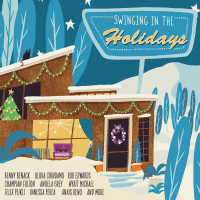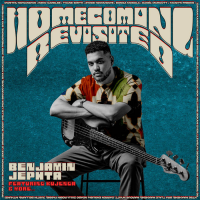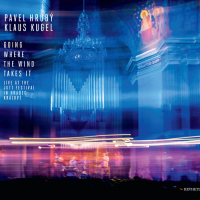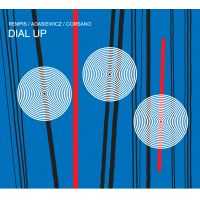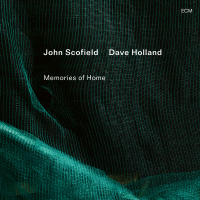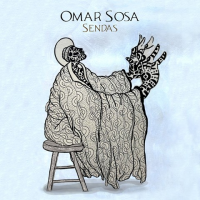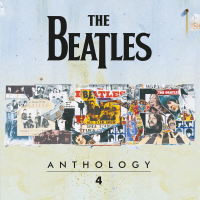Home » Jazz Articles » Album Review » JD Walter: Dressed in a Song
JD Walter: Dressed in a Song
Walter has a highly individual style which crosses the divide between speech and song. Two of his prime influences have been Betty Carter and the Brazilian singer, Milton Nascimento. From Carter during the later phases of her career, Walter learned to follow his own instincts rather than follow standard renditions. From Nascimento, he acquired an ability to sing almost as if speaking. He reaches the listener at deep and universal levels of understanding. His scatting has always drawn attention for its subtly complex improvisation, and he has developed a unique vocabulary of phonemes (distinct units of sound in a language) that reflect the nature of the human voice—an advance from the more typical "scat," which tries to sound like musical instruments. By contrast, some of Walter's previous recordings feature only few scat choruses. In this album the singer talks to the listener in a language of sounds rather than words.
Each track of the recording has differing personnel, carefully selected by Walter from among his cohorts to match the song and his interpretation of it. Most notably, each pianist plays on only one track.
The title track features pianist Taylor Eigsti in a Walter original arranged for vocal-piano duo. It is a languorous ballad about someone who gives him everything. She is "dressed in a song," meaning that, like a song, she fulfills him deeply. "Love came dressed in a song, ... like I was part of you...Seems like my second chance was not by chance at all." Walter has said (see below) that it was written for his loving adoptive mother, who expressed herself in music; hence she was "dressed in a song."
The most exciting track on the album features pianist Jim Ridl accompanying Walter on the standard "You Go To My Head" in a way that captures the frenzied mind of an intoxicated lover. Ridl's comping and solo here is one for the books. It is nothing less than stunning in its Art Tatum-like rapidity and virtuosity, subtle shifts of melody and harmony, and picking up on the lyrics to give them meaning in sound. Walter overdubs the ending, creating a chorus of his own voice-overs, conveying the state of multiple selves that love can bring. Another Walter original, "The Last Muse" is a ballad with Ben Wolfe on bass, Becca Stevens doing vocals accompanying Walter, and Obed Calvaire on drums. Wolf's bass initiates a single line introduction, and a charango (a smallish Andean guitar mentioned in the album notes) ensues. Light cymbal sounds enter. Singer Stevens shadows Walter's singing with delicate harmonies. There is a flowing piano solo with a Chopin-esque quality by Julius Rodriguez, ending up with subtle percussion work by Calvaire. The music has a melancholy feeling, a contemporary modal version of the blues.
For a simple but not simplistic version of the popular show song "What the World Needs Now," pianist Orrin Evans steps in, accompanying Walter with a walking bass line and block chords. Walter has learned a lot from early Milton Nascimento's "Travesia" ("The Bridge") in creating the vocal persona of a youngish person expressing a heartfelt sentiment. The piece has a childlike innocence to it, and Walters' second round of singing the tune is more assertive, less anxious, than the first, creating, through the development of the song, the feeling of a young man or woman coming of age.
"Brother John" is another Walter original, a plaintive song of forgiveness and compassion for a troubled dear friend who has died. It seems to have autobiographical significance for the singer: one supposes it to reflect an actual event of grief and loss in Walter's life (see below). Pianist Marc Cary provides a simple but strong piano accompaniment, creating a feeling of funereal music, a dirge.
"Can It Be Done?" features still another pianist, Jean-Michel Pilc in a song of contemplation about hope and disappointment. Pilc provides a well-thought-out contrast to Walter's laconic melodic line by marking the passage of time with faster-moving improvisations that are reminiscent of the way that Bach in his cantatas counterpointed a hymnal chorale with more elaborate decorative orchestrations.
The album concludes with a hymnal expression of the Welsh folk song "All Through the Night, , popularized by Cindi Lauper, whose lyrics reveal it to be not a church song but a lullaby. Here, the song is presented as a church hymn, but then suddenly Walter inserts a scat chorus where it is least expect it—maybe the child waking up—and it works! It ends with a chorus of voices chiming in like a church congregation. A Quaker woman once said that "religion is given to us at our mother's breast." In the same vein, hymns derive ultimately from the lullabies that our mother's sing to soothe and comfort us.
In a phone interview Walter revealed the source of his inspiration for the album: "I conceived the [it] with the idea of having different pianists on each track. I had many pianists in mind, and ended with six, having worked with all of them. I also wanted it to be a reflection of where I am emotionally and musically in my life."
Do the lyrics of his originals reflected events in his own life? He noted that "Dressed in a Song" was written for his mother. "I was adopted, and my adoptive mother was very loving and caring, a musician herself, and she showed me the wonders of music." "The Last Muse" is a "love story written for my girlfriend. "Brother John" was written shortly before the recording, a few months after my best childhood friend, now of course an adult, committed suicide."
This album takes us deeply into JD Walter's heart and soul, and by so doing speaks for all of us in our search for love, sense, and meaning in life. The arrangements and accompanying musicians grasp his intent throughout and provide the backdrop and inspiration for Walter to go into himself. It is a true, sincere expression of a singer who has devoted himself to the art of song. In this respect, it reaches a new level of achievement for him and may provide a fresh standard towards which other vocalists can aspire.
Track Listing
Dressed In A Song (Taylor Eigsti: piano); You Go To My Head (Jim Ridl: piano); The Last Muse (Obed Calvaire: percussion; Becca Stevens vocals; Ben Wolfe: bass; Julius Rodriguez: piano); What The World Needs Now (Orrin Evans: piano); Brother John (Marc Cary: piano); Can It Be Done? (Jean Michel Pilc: piano); All Through The Night.
Personnel
JD Walter
vocalsJim Ridl
pianoOrrin Evans
pianoTaylor Eigsti
pianoMarc Cary
pianoJean-Michel Pilc
pianoJulius Rodriguez
pianoBecca Stevens
vocalsBen Wolfe
bassObed Calvaire
drumsAlbum information
Title: Dressed in a Song | Year Released: 2020 | Record Label: JWAL Records
Tags
PREVIOUS / NEXT
Support All About Jazz
 All About Jazz has been a pillar of jazz since 1995, championing it as an art form and, more importantly, supporting the musicians who make it. Our enduring commitment has made "AAJ" one of the most culturally important websites of its kind, read by hundreds of thousands of fans, musicians and industry figures every month.
All About Jazz has been a pillar of jazz since 1995, championing it as an art form and, more importantly, supporting the musicians who make it. Our enduring commitment has made "AAJ" one of the most culturally important websites of its kind, read by hundreds of thousands of fans, musicians and industry figures every month.























